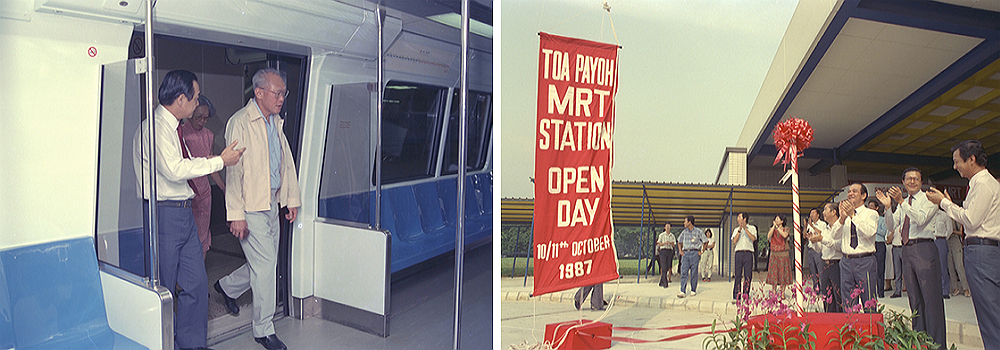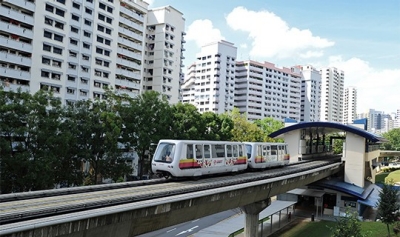Overall
From the past to the future
Singapore Changi Airport, the Mass Rapid Transit (MRT) and the Light Rail Transit (LRT) systems are the core components of the country's transport infrastructure and play a vital role in driving regional economic development and international exchanges. They are key infrastructure for Singapore to sustain its future market competitiveness. These transport networks enhance economic activity and improve the quality of life for residents by improving urban connectivity and accessibility. Continuous technological upgrades and network expansion ensure Singapore's attractiveness and competitiveness as a global city-state.
Singapore Changi Airport
1976 - the mid-2030s
Airports are crucial hubs linking regions worldwide for commerce, culture, and travel, fostering international ties and local economies. Singapore Changi Airport's development spans various phases, shaping both its history and future.
Source: Changi Airport
The MRT System
1987-2040
The urban public transportation system, particularly Singapore's MRT (Mass Rapid Transit), plays a vital role in enhancing traffic flow and air quality. It offers fast, dependable, and affordable mass transit, linking residential, commercial, and transportation hubs. With multiple lines covering extensive areas, the MRT efficiently handles high passenger volumes. Its underground and elevated routes minimize disruption to urban traffic, boosting operational efficiency.
Source: Land Transport Authority
The LRT System
From 1999 to future
Singapore's LRT (Light Rail Transit) system, found in areas like Bukit Panjang, Sengkang, and Punggol, complements the MRT by connecting residential zones to main stations. Operating mostly on the surface, sometimes alongside roads, these routes are flexible for short community trips.
Source: Land Transport Authority
Present
Overlay map of Changi Airport, MRT and LRT systems
(Hover over the feature for details and press 'Ctrl' to zoom)
1976 - 1981
Initial stage:

In 1976, reclamation and land preparation work on the Changi Airport site began. In 1979, the foundation stone for Changi Airport's first terminal building (Terminal 1) was laid. In 1981, Changi Airport officially began operations.
1986 - 2019
Implemented continuous expansion and upgrade phase:

1986: Construction of Terminal 2 began.
2006: Opening of the Budget Terminal, dedicated to budget aviation, and introduction of Asia's first luxury airport terminal facility.
2008: Terminal 3 opened.
2012: Terminal 1 was refurbished to introduce the Kinetic Rain art installation.
2017: Terminal 4 opened.
2019: Opening of Jewel Changi Airport, a mixed-use complex with retail, dining and entertainment facilities.
Future by the mid-30s of the 21st century
Future planning and technological upgrading phase:

Construction of T5 is expected to begin in 2025.T5 would incorporate a number of sustainable building and operational measures, for example, the use of solar panels, intelligent building management systems, district cooling systems, and so on, to ensure environmental sustainability. The design of Terminal 5 accommodates future traffic growth, with an annual capacity of approximately 50 million passengers. Operations at the terminal are anticipated to begin in the mid-2030s.
1987
Beginning:

The North-South Line, which is Singapore's first MRT line, has been operating, initially connecting five stations from Yio Chu Kang to Toa Payoh.
For the next a few years to the present
Expansion:
In subsequent years, the network was gradually expanded with the addition of the East-West Line, the Circle Line, the North East Line, the Downtown Line, and the Thomson-East Coast Line.
The future by 2040
Future developments:
The total network length would be expected to increase from the current 230 kilometers to about 450 kilometers by 2040. New lines coming into service include the Jurong Region Line and the Cross Island Line, which will be scheduled to open by phases from 2027 and 2030, respectively.
From 1999 to the present
The beginning and development:

1999: Singapore's first LRT line, the Bukit Panjang LRT (BPLRT), opened. This was Singapore's first attempt to provide convenient transit within residential areas.
2003: Sengkang LRT (SKLRT) opened. The route was designed to serve the rapidly developing Sengkang Newtown.
2005: The first phase of Punggol LRT (PGLRT) opened. Subsequently, as Punggol Newtown expanded, the LRT system was expanded accordingly.
2015 and afterwards: A series of upgrades and maintenance work has been carried out, particularly on the aging Bukit Panjang line, including upgrading the system and vehicles to improve reliability and efficiency.
Future
Future developments:
Future Planning: Under the Land Transport Authority's (LTA) long-term plan, the LRT system will continue to expand to accommodate the growth of emerging residential areas in northern and northeastern Singapore. This includes the possible construction of new lines or extension of existing lines.
Technology upgrades: More advanced train management and signaling systems are expected to be introduced to improve service frequency and reliability. Meanwhile, modernization of stations and vehicles to enhance passenger experience will also be part of future developments.